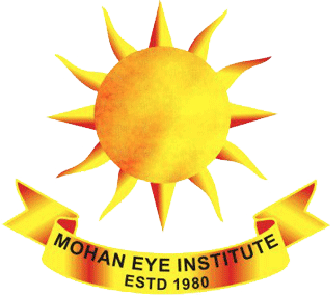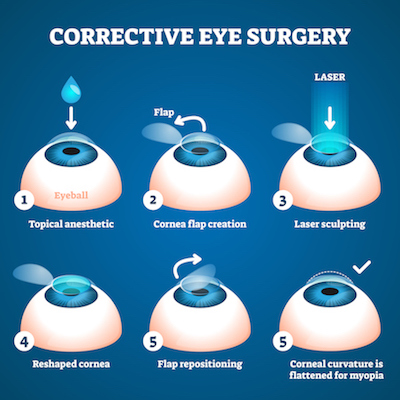Eligibility Criteria
- The patient’s eye prescription needs to be stable for at least 6 months to one year prior to surgery
- Patient should be at least 18 years old since the refraction/ glasses number of patients younger than 18 usually continues to change/ is unstable
- Pregnant patients or nursing patients are not eligible for LASIK as these conditions cause instability in the refraction of the eye
- The patient’s corneas are tested to be appropriately thick and appropriately shaped
- The patient should not have a history of dry eyes, as it may get aggravated with LASIK
- Patients should be in good general health and not be on medication that can impede healing. Certain conditions, such as lupus, rheumatoid arthritis, and diabetes, as well as drugs such as retinoic acid and steroids, may prevent proper healing after laser vision surgery.
Treatment
Evaluation
- Visual Acuity Test and Refraction
- Eye pressure Test (IOP Intra Ocular Pressure)
- Retina Examination (Fundus Exam) – To check the status of the retina
- Topography – To evaluate corneal surface contour and obtain a map of the cornea. This process also detects astigmatism and other irregularities in the shape of the cornea
- Pachymetry – To evaluate corneal thickness
Procedure
Preoperative
- Patients wearing soft contact lenses are usually instructed to stop wearing them 15 days before surgery
- An antibiotic eye-drop is prescribed beforehand to minimize the risk of infection after the procedure
LASIK Eye Surgery
The operation involves creating a thin flap on the eye, folding it to enable remodelling of the tissue beneath with a laser. The flap is repositioned and the eye is left to heal in the postoperative period.
The operation is performed with the patient awake and mobile and is administered anaesthetic eye drops.
For Myopic Eye (Short-sightedness / Minus number / Difficulty in viewing objects at a distance clearly)
In the myopic eye, the corneal (and/or lens) curvature is steep/ more curved and focuses the image to a point in front of the retina. The image therefore appears blurred. During LASIK, the laser lightly flattens the cornea such that the image is clearly focused on the retina.
For Hypermetropic Eye (Far-sightedness / Plus number / Difficulty in viewing near objects)
In the hypermetropic eye, the corneal (and/or lens) curvature is flatter/ less curved and focuses the image to a point behind the retina. The image therefore appears blurred. During LASIK, the laser corrects the cornea to steepen its curvature such that the image is clearly focused on the retina.
For Astigmatic Eye (Cylindrical number)
In the astigmatic eye, the corneal (and/or lens) curvature is not circular; rather it is oval similar to a rugby ball and therefore focuses the image in two planes leading to blurred vision. During LASIK, the laser corrects the cornea to steepen or flatten its curvature in one plane such that the image is clearly focused on the retina.
LASIK at MEI
Types of LASIK LASIK Surgery can be done using a blade (Blade LASIK) or without a blade (Bladeless LASIK/ Femto LASIK)
- In Blade LASIK an automated blade (microkeratome) is used to create the corneal flap. This is followed by an Excimer Laser which reshapes the corneal tissue. The flap is then put back to its original position.
- In Bladeless LASIK, the surgeon uses two types of lasers. First an Ultra-Fast FEMTO Second Laser creates a very thin corneal flap. Then, the Excimer Laser reshapes the corneal tissue. The flap is then put back to its original position.
The major advantage of Bladeless LASIK over Blade LASIK is that it allows obtaining thinner flaps and therefore a higher degree of refractive error can be corrected especially for patients with thinner corneal thickness. Customized LASIK / Wavefront technology In customized LASIK procedure, not only the power of your glasses is treated, but also helps in treatment of high-order abnormalities and refractive errors. The goal is to achieve a more optically perfect eye. After undergoing this customized treatment, patients may achieve a higher quality of vision (HD vision) which is better than normal vision with minimal glare.
FAQs
What is PRK (Photorefractive Keratectomy)?
PRK (Photorefractive Keratectomy) is a procedure in which the top layer of the cornea is removed and the laser is then applied directly to the cornea. It doesn’t involve the creation of a partial thickness corneal flap.
What is ICL (Implantable Collamer Lens)?
ICL (Implantable Collamer Lens) is a procedure in which an artificial lens is placed inside the eye to help focus light onto the retina. This is also offered to patients who may not be eligible for LASIK but want to do away with their glasses.
What is better - LASIK or PRK?
LASIK offers faster patient recovery
In PRK there may be some pain and blurred vision for 3-5 days after the surgery, which is easily treated with eye drops and special contact lenses. This is recommended to patients with thin corneas, specially those who are in combat related professions or engaged in contact sports.
How long does the surgery take?
For most patients, both eyes are treated in the same sitting. The procedure may last for 10 to 15 minutes.
Is LASIK Eye Surgery painful?
Anesthetic drops are put in the eyes, after which LASIK is a pain-free procedure. Some patients might feel a pressure sensation for a few minutes.
When can normal daily activities be resumed?
Daily activities can be resumed in 3-4 days. Swimming and eye makeup should be avoided for a month.
Is the surgery permanent?
Yes it is, however you will need reading glasses once you reach presbyopic age.
Is LASIK safe?
LASIK is one of the safest surgeries. However, as with any surgery, there are certain risks involved which a patient should understand and accept before surgery. Do discuss this in detail with your surgeon.
How soon after LASIK may I resume driving?
You can start driving as soon as you can see well enough, which would be 2-3 days after the surgery. Night driving should be avoided for 2-3 weeks since there could be a glare.
How soon can I get back to work after the surgery?
Most people return to work the day after LASIK eye surgery. You should take the day off on the day of the surgery. In case of PRK a patient is recommended to rest for 4-5 days.
What happens after LASIK?
You may have blurred vision for a few hours after the surgery. Most people report clear vision after a few hours to within a few days of the surgery. Some patients may experience mild discomfort which is easily relieved by medicines.
The surgeon will explain the care and precautions needed after the surgery, and also the follow up visits required.
What is the Bladeless LASIK uses iLASIK technology?
This is a new blade-free technique, where no blade is used in the LASIK surgery.
The IntraLaseTM method uses a specialized laser called Femtosecond laser instead of an oscillating blade for creating the corneal flap. This is the thin flap of tissue that the surgeon folds back in order to perform the excimer laser vision correction. This is done by focusing the laser at an exact location below the surface of the cornea. By directing thousands of such individual laser pulses side by side one can create a cut within the cornea without the use of a blade.
This means that in this surgery no blade will touch your eye, making the new iLASIK procedure extremely safe.

